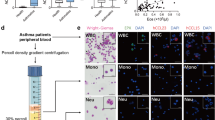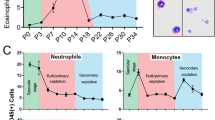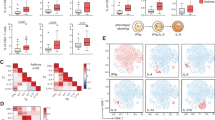Abstract
Eosinophils play important roles in asthma and lung infections. Murine models are widely used for assessing the functional significance and mechanistic basis for eosinophil involvements in these diseases. However, little is known about tissue eosinophils in homeostasis. In addition, little data on eosinophil chemokine production during allergic airway inflammation are available. In this study, the properties and functions of homeostatic and activated eosinophils were compared. Eosinophils from normal tissues expressed costimulation and adhesion molecules B7-1, B7-2 and ICAM-1 for Ag presentation but little major histocompatibility complex (MHC) class II, and were found to be poor stimulators of T-cell proliferation. However, these eosinophils expressed high levels of chemokine mRNA including C10, macrophage inflammatory protein (MIP)-1α, MIP-1γ, MIP-2, eotaxin and monocyte chemoattractant protein-5 (MCP-5), and produced chemokine proteins. Eosinophil intracellular chemokines decreased rapidly with concomitant surface marker downregulation upon in vitro culturing consistent with piecemeal degranulation. Lung eosinophils from mice with induced allergic airway inflammation exhibited increased chemokines mRNA expression and chemokines protein production and upregulated MHC class II and CD11c expression. They were also found to be the predominant producers of the CCR1 ligands CCL6/C10 and CCL9/MIP-1γ in inflamed lungs. Eosinophil production of C10 and MIP-1γ correlated with the marked influx of CD11bhigh lung dendritic cells during allergic airway inflammation and the high expression of CCR1 on these dendritic cells (DCs). The study provided baseline information on tissue eosinophils, documented the upregulation of activation markers and chemokine production in activated eosinophils, and indicated that eosinophils were a key chemokine-producing cell type in allergic lung inflammation.
This is a preview of subscription content, access via your institution
Access options
Subscribe to this journal
Receive 12 digital issues and online access to articles
$119.00 per year
only $9.92 per issue
Buy this article
- Purchase on Springer Link
- Instant access to full article PDF
Prices may be subject to local taxes which are calculated during checkout









Similar content being viewed by others
References
Blanchard C, Rothenberg ME . Biology of the eosinophil. Adv Immunol 2009; 101: 81–121.
Rothenberg ME, Hogan SP . The eosinophil. Annu Rev Immunol 2006; 24: 147–174.
Shi HZ, Humbles A, Gerard C, Jin Z, Weller PF . Lymph node trafficking and antigen presentation by endobronchial eosinophils. J Clin Invest 2000; 105: 945–953.
Kay AB . Allergy and allergic diseases. First of two parts. N Engl J Med 2001; 344: 30–37.
Kay AB . Allergy and allergic diseases. Second of two parts. N Engl J Med 2001; 344: 109–113.
Ellis A . The pathological anatomy of bronchial asthma. Am J Med Sci 1908; 136: 407–429.
Bousquet J, Chanez P, Lacoste JY, Barneon G, Ghavanian N, Enander I et al. Eosinophilic inflammation in asthma. N Engl J Med 1990; 323: 1033–1039.
Jacobsen EA, Ochkur SI, Lee NA, Lee JJ . Eosinophils and asthma. Curr Allergy Asthma Rep 2007; 7: 18–26.
Kay AB . The role of eosinophils in the pathogenesis of asthma. Trends Mol Med 2005; 11: 148–152.
Zarogiannis S, Gourgoulianis KI, Kostikas K, Szczeklik A, Gleich GJ, Pavord ID et al. Anti-interleukin-5 therapy and severe asthma. N Engl J Med 2009; 360: 2576–2578.
Garrett JK, Jameson SC, Thomson B, Collins MH, Wagoner LE, Freese DK et al. Anti-interleukin-5 (mepolizumab) therapy for hypereosinophilic syndromes. J Allergy Clin Immunol 2004; 113: 115–119.
Plotz SG, Simon HU, Darsow U, Simon D, Vassina E, Yousefi S et al. Use of an anti-interleukin-5 antibody in the hypereosinophilic syndrome with eosinophilic dermatitis. N Engl J Med 2003; 349: 2334–2339.
Straumann A, Conus S, Grzonka P, Kita H, Kephart G, Bussmann C et al. Anti-interleukin-5 antibody treatment (mepolizumab) in active eosinophilic oesophagitis: a randomised, placebo-controlled, double-blind trial. Gut 2010; 59: 21–30.
Wierenga EA, Snoek M, de Groot C, Chretien I, Bos JD, Jansen HM et al. Evidence for compartmentalization of functional subsets of CD2+ T lymphocytes in atopic patients. J Immunol 1990; 144: 4651–4656.
Hamaguchi-Tsuru E, Nobumoto A, Hirose N, Kataoka S, Fujikawa-Adachi K, Furuya M et al. Development and functional analysis of eosinophils from murine embryonic stem cells. Br J Haematol 2004; 124: 819–827.
Foster PS, Hogan SP, Ramsay AJ, Matthaei KI, Young IG . Interleukin 5 deficiency abolishes eosinophilia, airways hyperreactivity, and lung damage in a mouse asthma model. J Exp Med 1996; 183: 195–201.
Hogan SP, Koskinen A, Foster PS . Interleukin-5 and eosinophils induce airway damage and bronchial hyperreactivity during allergic airway inflammation in BALB/c mice. Immunol Cell Biol 1997; 75: 284–288.
Hamelmann E, Oshiba A, Loader J, Larsen GL, Gleich G, Lee J et al. Antiinterleukin-5 antibody prevents airway hyperresponsiveness in a murine model of airway sensitization. Am J Respir Crit Care Med 1997; 155: 819–825.
Flood-Page P, Swenson C, Faiferman I, Matthews J, Williams M, Brannick L et al. A study to evaluate safety and efficacy of mepolizumab in patients with moderate persistent asthma. Am J Respir Crit Care Med 2007; 176: 1062–1071.
Kips JC, O’Connor BJ, Langley SJ, Woodcock A, Kerstjens HA, Postma DS et al. Effect of SCH55700, a humanized anti-human interleukin-5 antibody, in severe persistent asthma: a pilot study. Am J Respir Crit Care Med 2003; 167: 1655–1659.
Leckie MJ, ten Brinke A, Khan J, Diamant Z, O’Connor BJ, Walls CM et al. Effects of an interleukin-5 blocking monoclonal antibody on eosinophils, airway hyper-responsiveness, and the late asthmatic response. Lancet 2000; 356: 2144–2148.
Flood-Page PT, Menzies-Gow AN, Kay AB, Robinson DS . Eosinophil’s role remains uncertain as anti-interleukin-5 only partially depletes numbers in asthmatic airway. AmJ Respir Crit Care Med 2003; 167: 199–204.
Haldar P, Brightling CE, Hargadon B, Gupta S, Monteiro W, Sousa A et al. Mepolizumab and exacerbations of refractory eosinophilic asthma. N Engl J Med 2009; 360: 973–984.
Nair P, Pizzichini MM, Kjarsgaard M, Inman MD, Efthimiadis A, Pizzichini E et al. Mepolizumab for prednisone-dependent asthma with sputum eosinophilia. N Engl J Med 2009; 360: 985–993.
Lee JJ, Dimina D, Macias MP, Ochkur SI, McGarry MP, O’Neill KR et al. Defining a link with asthma in mice congenitally deficient in eosinophils. Science 2004; 305: 1773–1776.
Walsh ER, Sahu N, Kearley J, Benjamin E, Kang BH, Humbles A et al. Strain-specific requirement for eosinophils in the recruitment of T cells to the lung during the development of allergic asthma. J Exp Med 2008; 205: 1285–1292.
Jacobsen EA, Ochkur SI, Pero RS, Taranova AG, Protheroe CA, Colbert DC et al. Allergic pulmonary inflammation in mice is dependent on eosinophil-induced recruitment of effector T cells. J Exp Med 2008; 205: 699–710.
Corry DB, Folkesson HG, Warnock ML, Erle DJ, Matthay MA, Wiener-Kronish JP et al. Interleukin 4, but not interleukin 5 or eosinophils, is required in a murine model of acute airway hyperreactivity. J Exp Med 1996; 183: 109–117.
Humbles AA, Lloyd CM, McMillan SJ, Friend DS, Xanthou G, McKenna EE et al. A critical role for eosinophils in allergic airways remodeling. Science 2004; 305: 1776–1779.
Mattes J, Yang M, Mahalingam S, Kuehr J, Webb DC, Simson L et al. Intrinsic defect in T cell production of interleukin (IL)-13 in the absence of both IL-5 and eotaxin precludes the development of eosinophilia and airways hyperreactivity in experimental asthma. J Exp Med 2002; 195: 1433–1444.
Wills-Karp M, Luyimbazi J, Xu X, Schofield B, Neben TY, Karp CL et al. Interleukin-13: central mediator of allergic asthma. Science 1998; 282: 2258–2261.
Nakajima T, Yamada H, Iikura M, Hirai K . Intracellular localization and release of eotaxin from normal eosinophils. FEBS Lett 1998; 434: 226–230.
Ying S, Meng Q, Taborda-Barata L, Corrigan CJ, Barkans J, Assoufi B et al. Human eosinophils express messenger RNA encoding RANTES and store and release biologically active RANTES protein. Eur J Immunol 1996; 26: 70–76.
Culley FJ, Brown A, Girod N, Pritchard DI, Williams TJ . Innate and cognate mechanisms of pulmonary eosinophilia in helminth infection. Eur J Immunol 2002; 32: 1376–1385.
Dixon H, Blanchard C, Deschoolmeester ML, Yuill NC, Christie JW, Rothenberg ME et al. The role of Th2 cytokines, chemokines and parasite products in eosinophil recruitment to the gastrointestinal mucosa during helminth infection. Eur J Immunol 2006; 36: 1753–1763.
Dombrowicz D, Capron M . Eosinophils, allergy and parasites. Curr Opin Immunol 2001; 13: 716–720.
Gunther C, Wozel G, Dressler J, Meurer M, Pfeiffer C . Tissue eosinophilia in pemphigoid gestationis: association with eotaxin and upregulated activation markers on transmigrated eosinophils. Am J Reprod Immunol 2004; 51: 32–39.
Ochkur SI, Jacobsen EA, Protheroe CA, Biechele TL, Pero RS, McGarry MP et al. Coexpression of IL-5 and eotaxin-2 in mice creates an eosinophil-dependent model of respiratory inflammation with characteristics of severe asthma. J Immunol 2007; 178: 7879–7889.
Sung S, Rose CE, Fu SM . Intratracheal priming with ovalbumin- and ovalbumin 323–339 peptide-pulsed dendritic cells induces airway hyperresponsiveness, lung eosinophilia, goblet cell hyperplasia, and inflammation. J Immunol 2001; 166: 1261–1271.
Inaba K, Inaba M, Romani N, Aya H, Deguchi M, Ikehara S et al. Generation of large numbers of dendritic cells from mouse bone marrow cultures supplemented with granulocyte/macrophage colony-stimulating factor. J Exp Med 1992; 176: 1693–1702.
Finotto S, Neurath MF, Glickman JN, Qin S, Lehr HA, Green FH et al. Development of spontaneous airway changes consistent with human asthma in mice lacking T-bet. Science 2002; 295: 336–338.
Levitt RC, Ewart SL . Genetic susceptibility to atracurium-induced bronchoconstriction. Am J Respir Crit Care Med 1995; 151: 1537–1542.
Sung SS, Fu SM, Rose CE Jr, Gaskin F, Ju ST, Beaty SR . A major lung CD103 (alphaE)-beta7 integrin-positive epithelial dendritic cell population expressing Langerin and tight junction proteins. J Immunol 2006; 176: 2161–2172.
Nishikomori R, Ehrhardt RO, Strober W . T helper type 2 cell differentiation occurs in the presence of interleukin 12 receptor beta2 chain expression and signaling. J Exp Med 2000; 191: 847–858.
Beaty SR, Rose CE Jr, Sung SS . Diverse and potent chemokine production by lung CD11bhigh dendritic cells in homeostasis and in allergic lung inflammation. J Immunol 2007; 178: 1882–1895.
Prussin C, Metcalfe DD . 4. IgE, mast cells, basophils, and eosinophils. J Allergy Clin Immunol 2003; 111: S486–S494.
Zhang JQ, Biedermann B, Nitschke L, Crocker PR . The murine inhibitory receptor mSiglec-E is expressed broadly on cells of the innate immune system whereas mSiglec-F is restricted to eosinophils. Eur J Immunol 2004; 34: 1175–1184.
Dvorak AM, Furitsu T, Letourneau L, Ishizaka T, Ackerman SJ . Mature eosinophils stimulated to develop in human cord blood mononuclear cell cultures supplemented with recombinant human interleukin-5. Part I. Piecemeal degranulation of specific granules and distribution of Charcot-Leyden crystal protein. Am J Pathol 1991; 138: 69–82.
Jacobsen EA, Taranova AG, Lee NA, Lee JJ . Eosinophils: singularly destructive effector cells or purveyors of immunoregulation? J Allergy Clin Immunol 2007; 119: 1313–1320.
van Rijt LS, Vos N, Hijdra D, de Vries VC, Hoogsteden HC, Lambrecht BN . Airway eosinophils accumulate in the mediastinal lymph nodes but lack antigen-presenting potential for naive T cells. J Immunol 2003; 171: 3372–3378.
Throsby M, Herbelin A, Pleau JM, Dardenne M . CD11c+ eosinophils in the murine thymus: developmental regulation and recruitment upon MHC class I-restricted thymocyte deletion. J Immunol 2000; 165: 1965–1975.
Dajotoy T, Andersson P, Bjartell A, Lofdahl CG, Tapper H, Egesten A . Human eosinophils produce the T cell-attracting chemokines MIG and IP-10 upon stimulation with IFN-gamma. J Leukoc Biol 2004; 76: 685–691.
Izumi S, Hirai K, Miyamasu M, Takahashi Y, Misaki Y, Takaishi T et al. Expression and regulation of monocyte chemoattractant protein-1 by human eosinophils. Eur J Immunol 1997; 27: 816–824.
Moqbel R, Levi-Schaffer F, Kay AB . Cytokine generation by eosinophils. J Allergy Clin Immunol 1994; 94: 1183–1188.
Persson T, Monsef N, Andersson P, Bjartell A, Malm J, Calafat J et al. Expression of the neutrophil-activating CXC chemokine ENA-78/CXCL5 by human eosinophils. Clin Exp Allergy 2003; 33: 531–537.
Persson-Dajotoy T, Andersson P, Bjartell A, Calafat J, Egesten A . Expression and production of the CXC chemokine growth-related oncogene-alpha by human eosinophils. J Immunol 2003; 170: 5309–5316.
Schraufstatter I, Takamori H, Sikora L, Sriramarao P, DiScipio RG . Eosinophils and monocytes produce pulmonary and activation-regulated chemokine, which activates cultured monocytes/macrophages. Am J Physiol Lung Cell Mol Physiol 2004; 286: L494–L501.
Olszewska-Pazdrak B, Casola A, Saito T, Alam R, Crowe SE, Mei F et al. Cell-specific expression of RANTES, MCP-1, and MIP-1alpha by lower airway epithelial cells and eosinophils infected with respiratory syncytial virus. J Virol 1998; 72: 4756–4764.
Hogaboam CM, Gallinat CS, Taub DD, Strieter RM, Kunkel SL, Lukacs NW . Immunomodulatory role of C10 chemokine in a murine model of allergic bronchopulmonary aspergillosis. J Immunol 1999; 162: 6071–6079.
Ma B, Zhu Z, Homer RJ, Gerard C, Strieter R, Elias JA . The C10/CCL6 chemokine and CCR1 play critical roles in the pathogenesis of IL-13-induced inflammation and remodeling. J Immunol 2004; 172: 1872–1881.
Berahovich RD, Miao Z, Wang Y, Premack B, Howard MC, Schall TJ . Proteolytic activation of alternative CCR1 ligands in inflammation. J Immunol 2005; 174: 7341–7351.
Blease K, Mehrad B, Standiford TJ, Lukacs NW, Kunkel SL, Chensue SW et al. Airway remodeling is absent in CCR1–/– mice during chronic fungal allergic airway disease. J Immunol 2000; 165: 1564–1572.
Domachowske JB, Bonville CA, Gao JL, Murphy PM, Easton AJ, Rosenberg HF . The chemokine macrophage-inflammatory protein-1 alpha and its receptor CCR1 control pulmonary inflammation and antiviral host defense in paramyxovirus infection. J Immunol 2000; 165: 2677–2682.
John AE, Gerard CJ, Schaller M, Miller AL, Berlin AA, Humbles AA et al. Respiratory syncytial virus-induced exaggeration of allergic airway disease is dependent upon CCR1-associated immune responses. Eur J Immunol 2005; 35: 108–116.
Schaller MA, Kallal LE, Lukacs NW . A key role for CC chemokine receptor 1 in T-cell-mediated respiratory inflammation. Am J Pathol 2008; 172: 386–394.
Murphy PM, Baggiolini M, Charo IF, Hebert CA, Horuk R, Matsushima K et al. International union of pharmacology. XXII. Nomenclature for chemokine receptors. Pharmacol Rev 2000; 52: 145–176.
Ma B, Liu W, Homer RJ, Lee PJ, Coyle AJ, Lora JM et al. Role of CCR5 in the pathogenesis of IL-13-induced inflammation and remodeling. J Immunol 2006; 176: 4968–4978.
Schuh JM, Blease K, Hogaboam CM . The role of CC chemokine receptor 5 (CCR5) and RANTES/CCL5 during chronic fungal asthma in mice. FASEB J 2002; 16: 228–230.
Tregoning JS, Pribul PK, Pennycook AM, Hussell T, Wang B, Lukacs N et al. The chemokine MIP1alpha/CCL3 determines pathology in primary RSV infection by regulating the balance of T cell populations in the murine lung. PLoS one 2010; 5: e9381.
Srivastava P, Helms PJ, Stewart D, Main M, Russell G . Association of CCR5Delta32 with reduced risk of childhood but not adult asthma. Thorax 2003; 58: 222–226.
Gutierrez-Ramos JC, Lloyd C, Kapsenberg ML, Gonzalo JA, Coyle AJ . Non-redundant functional groups of chemokines operate in a coordinate manner during the inflammatory response in the lung. Immunol Rev 2000; 177: 31–42.
Acknowledgements
We thank Mr Bin-Ru Wang, Mr Michael Solga and Ms Linda Mardel for excellent technical assistance. This work was supported in part by the National Institutes of Health Grants HL070065, AI079906 (SJS), HL065344 (CER), AR049449, AR047988 (SMF), HL065228 and K26-RR019709 (JJL), and grants from the Mayo Foundation and American Heart Association (045580Z) (JJL).
Author information
Authors and Affiliations
Corresponding author
Rights and permissions
About this article
Cite this article
Rose, C., Lannigan, J., Kim, P. et al. Murine lung eosinophil activation and chemokine production in allergic airway inflammation. Cell Mol Immunol 7, 361–374 (2010). https://doi.org/10.1038/cmi.2010.31
Received:
Revised:
Accepted:
Published:
Issue Date:
DOI: https://doi.org/10.1038/cmi.2010.31
Keywords
This article is cited by
-
CD146 deficiency promotes inflammatory type 2 responses in pulmonary cryptococcosis
Medical Microbiology and Immunology (2023)
-
FoxO1 suppresses IL-10 producing B cell differentiation via negatively regulating Blimp-1 expression and contributes to allergic asthma progression
Mucosal Immunology (2022)
-
A cardioimmunologist’s toolkit: genetic tools to dissect immune cells in cardiac disease
Nature Reviews Cardiology (2022)
-
Eosinophil-derived CCL-6 impairs hematopoietic stem cell homeostasis
Cell Research (2018)
-
Chemokine and chemotactic signals in dendritic cell migration
Cellular & Molecular Immunology (2018)



